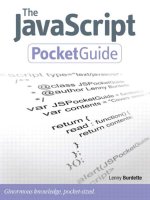THE VEST POCKET CFO pps
Bạn đang xem bản rút gọn của tài liệu. Xem và tải ngay bản đầy đủ của tài liệu tại đây (4 MB, 867 trang )
THE
VEST
POCKET
CFO
Third Edition
Jae K. Shim, Ph.D.
Joel G. Siegel, Ph.D., CPA
John Wiley & Sons, Inc.
THE
VEST
POCKET
CFO
Third Edition
Jae K. Shim, Ph.D.
Joel G. Siegel, Ph.D., CPA
John Wiley & Sons, Inc.
This book is printed on acid-free paper.
Copyright © 2008 by John Wiley & Sons, Inc. All rights reserved.
Published by John Wiley & Sons, Inc., Hoboken, New Jersey.
Published simultaneously in Canada.
Wiley Bicentennial Logo: Richard J. Pacifico
No part of this publication may be reproduced, stored in a retrieval
system, or transmitted in any form or by any means, electronic,
mechanical, photocopying, recording, scanning, or otherwise, except as
permitted under Section 107 or 108 of the 1976 United States Copyright
Act, without either the prior written permission of the Publisher, or
authorization through payment of the appropriate per-copy fee to the
Copyright Clearance Center, Inc., 222 Rosewood Drive, Danvers,
MA 01923, 978-750-8400, fax 978-646-8600, or on the web at
www.copyright.com. Requests to the Publisher for permission should be
addressed to the Permissions Department, John Wiley & Sons, Inc., 111
River Street, Hoboken, NJ 07030, 201-748-6011, fax 201-748-6008, or online
at />Limit of Liability/Disclaimer of Warranty: While the publisher and
author have used their best efforts in preparing this book, they make no
representations or warranties with respect to the accuracy or
completeness of the contents of this book and specifically disclaim any
implied warranties of merchantability or fitness for a particular purpose.
No warranty may be created or extended by sales representatives or
written sales materials. The advice and strategies contained herein may
not be suitable for your situation. You should consult with a professional
where appropriate. Neither the publisher nor author shall be liable for
any loss of profit or any other commercial damages, including but not
limited to special, incidental, consequential, or other damages.
For general information on our other products and services, or technical
support, please contact our Customer Care Department within the United
States at 800-762-2974, outside the United States at 317-572-3993 or
fax 317-572-4002.
Wiley also publishes its books in a variety of electronic formats. Some
content that appears in print, may not be available in electronic books.
For more information about Wiley products, visit our Web site at
.
Library of Congress Cataloging-in-Publication Data:
Shim, Jae K.
The vest pocket CFO / Jae K. Shim, Joel G. Siegel.–3rd ed.
p. cm.
Includes index
ISBN 978-0-470-16812-7 (pbk. : acid-free paper)
1. Corporations–United States–Finance–Handbooks, manuals, etc.
I. Siegel, Joel G. II. Title.
HG4061.S48 2008
658.15–dc22
2007020669
Printed in the United States of America.
10987654321
This book is dedicated to
Chung Shim, dedicated wife;
Roberta M. Siegel, loving wife and
colleague; and
Sylvia and Arnold Siegel,
loving mother and brother
ABOUT THE AUTHORS
Dr. Jae K. Shim, Ph.D., is one of the most prolific account-
ing and finance experts in the world. He is a professor
of accounting and finance at California State University,
Long Beach, and CEO of Delta Consulting Company, a
financial consulting and training firm. Dr. Shim received
his M.B.A. and Ph.D. degrees from the University of
California at Berkeley (Haas School of Business). He has
been a consultant to commercial and nonprofit organiza-
tions for over 30 years.
Dr. Shim has over 50 college and professional books
to his credit, including Barron’s Accounting Handbook,
Barron’s Dictionary of Accounting Terms, GAAP 2008,
Dictionary of Personal Finance, Investment Source-
book, Dictionary of Real Estate, Dictionary of Economics,
Dictionary of International I nvestment Terms, Encyclopedic
Dictionary of Accounting and Finance, 2007–2008 Corpo-
rate Controller’s Handbook of Financial Management, The
Vest Pocket CPA, and the best-selling Vest Pocket MBA.
Twenty-two of his publications have been translated into
foreign languages such as Spanish, Chinese, Russian, Ital-
ian, Japanese, and Korean. Professor Shim’s books have
been published by Prentice-Hall, McGraw-Hill, Barron’s,
Commercial Clearing House (CCH), Southwestern, John
Wiley, American Management Association (Amacom),
and the American Institute of CPAs (AICPA).
Dr. Shim has been frequently quoted by such media
as the Los Angeles Times, Orange County Register, Busi-
ness Start-ups, Personal Finance, and Money Radio. He has
also published numerous articles in professional and aca-
demic journals. Dr. Shim was the recipient of the Credit
Research Foundation Award for his article on financial
management.
Joel G. Siegel, Ph.D., CPA, is a financial consultant and
professor of accounting and finance at Queens College of
the City University of New York.
He was previously employed by Coopersand Lybrand,
CPAs, and Arthur Andersen, CPAs. Dr. Siegel has acted
as a consultant to many organizations, including Citicorp,
v
vi About the Authors
International Telephone and Telegraph, United Technolo-
gies, American Institute of CPAs, and Person-Wolinsky
Associates.
Dr. Siegel is the author of 67 books and about 300
articles on accounting and financial topics. His books
have been published by Prentice Hall, McGraw-Hill,
Harper-Collins, John Wiley & Sons, Inc., Macmillan, Inter-
national Publishing,Barron’s, Southwestern, Aspen, Richard
Irwin, Probus, American Management Association, and
the American Institute of CPAs.
Dr. Siegel’s articles have been published in many
accounting and financial journals, including Financial
Executive, The Financial Analysts Journal, The CPA Journal,
Practical Accountant,andtheNational Public Accountant.
In 1972 he was the recipient of the Outstanding Educa-
tor of America Award. Dr. Siegel is listed in Who’s Where
Among Writers and Who’s Who in the World. His interna-
tional reputation led to his appointment in 1992 as chair
of the National Oversight Board.
CONTENTS
What This Book Will Do
for You xix
Part 1 Reports and Filings
One Chief Financial Officer’s Reports 3
Governmental Reporting
●
7
Reporting Under the Sarbanes-Oxley
Act
●
8
Other Reporting
●
9
Two Securities and Exchange Commission
Filings 10
Form S-1
●
11
Form S-2
●
11
Form S-3
●
11
Form S-4
●
11
Form S-8
●
11
Form S-18
●
12
Part 2 Financial Accounting
Three Financial Statement Reporting:
The Income Statement 19
Revenue Recognition
●
22
Construction Contracts
●
23
Expense Recognition
●
30
Four Financial Statement Reporting: The
Balance Sheet 38
Inventory
●
42
RetailLowerofCostorMarketValue
Method (Conventional Retail)
●
44
Retail LIFO
●
44
Losses on Purchase Commitment
●
47
Inventory Valuation Problems
●
47
Inventory Stated at Market Value in
Excess of Cost
●
47
Disclosure
●
55
Accounting for Compensated
Absences
●
66
vii
viii Contents
Environmental Obligations
●
68
Exit or Disposal Activities
●
70
Fair Value Measurements
●
71
The Fair Value Option for Financial
Assets and Financial Liabilities
●
73
Electing the Fair Value Option
●
74
Events
●
75
Instrument Application
●
75
Balance Sheet
●
76
Statement of Cash Flows
●
76
Disclosures
●
76
Eligible Items at Effective Date
●
78
Available-for-Sale and Held-to-
Maturity Securities
●
79
Five Statement of Cash Flows 92
Analysis of the Statement of Cash
Flows
●
96
Six Accounting and Disclosures 105
Accounting Changes
●
105
Debtor
●
111
Creditor
●
113
Seven Key Financial Accounting Areas 124
Investments in Stocks and Bonds
●
126
Leases
●
137
Lessee
●
138
Lessor
●
141
Pension Plans
●
149
Postretirement Benefits Excluding
Pensions
●
161
Income Tax Allocation
●
165
Deferred Tax Liability vs. Deferred Tax
Asset
●
168
Tax Rates
●
171
Extensions of Tax Allocation
●
173
Temporary Difference
●
173
Amount of Temporary
Difference
●
174
Foreign Currency Accounting
●
174
Translation of Foreign Currency
Statements When the Foreign
Currency Is the Functional
Currency
●
178
Contents ix
Eight Interim and Segmental Reporting 185
Part 3 Management Accounting
Nine Cost Management and Analysis 197
Overhead Costing: A Single-Product
Situation
●
198
Overhead Costing: A Multiple-Product
Situation
●
199
Plantwide Overhead Rate
●
200
Departmental Rates
●
200
Plantwide Rate Versus Departmental
Rates
●
202
Problems with Costing Accuracy
●
202
Non–Volume-Related Overhead
Costs
●
203
Product Diversity
●
204
First-Stage P rocedure
●
205
Second-Stage Procedure
●
205
Comparison of Product Costs
●
206
The Cost of Measurement
●
207
Indirect Measures and the Degree of
Correlation
●
208
Ten Cost-Volume-Profit Analysis and
Leverage 216
Eleven Short-Term Decisions 230
Twelve Financial Forecasting, Planning, and
Budgeting 243
The Sales Budget
●
249
The Production Budget
●
251
The Direct Material Budget
●
251
The Direct Labor Budget
●
254
The Factory Overhead Budget
●
254
The Ending Inventory Budget
●
257
The Selling and Administrative Expense
Budget
●
257
The Cash Budget
●
259
The Budgeted Income Statement
●
259
The Budgeted Balance Sheet
●
263
Some Financial Calculations
●
263
Budgeting Software
●
263
The Latest Generation of Budgeting
and Planning (B&P) Software
●
266
x Contents
Thirteen Risk Management 271
An Approach to Risk
Management
●
272
A Close Look at Risk
Management
●
274
How to Reduce Investment Risk:
Diversify
●
277
Beta—the Capital Asset Pricing Model
(CAPM)
●
281
The Arbitrage Pricing Model
(APM)
●
283
Fourteen Capital Budgeting 286
Time Value Fundamentals
●
287
Payback Period
●
292
Accounting (Simple) Rate o f
Return
●
294
Net Present Value Method
●
295
Internal Rate of Return
●
296
Profitability Index (or Present Value
Index)
●
299
Limited Funds for Capital
Spending
●
300
Effect of Income Taxes on Capital
Budgeting Decisions
●
303
Fifteen The What and Why of R esponsibility
Accounting 310
Cost Center Performance and
Standard Costs
●
313
General Model for Variance
Analysis
●
313
Flexible Budgets and Performance
Reports
●
318
Production Mix and Yield
Variances
●
324
Sixteen Control of Profit Centers 330
Profit Variance Analysis
●
332
Seventeen Performance of Investment Centers
and Transfer Pricing 341
Rate of Return on Investment
(ROI)
●
341
Residual Income (RI)
●
342
Contents xi
Investment Decisions Under ROI and
RI
●
343
Residual Income and Economic Value
Added
●
344
Transfer Pricing
●
344
Eighteen How to Analyze and Improve
Corporate Profitability and
Shareholder Value 350
Balanced Scorecard
●
361
Economic Value Added (EVA
®
)
●
365
EVA and Value Creation
●
367
More on NOPAT
●
367
Capital Charge
●
369
Key Features of EVA
●
369
What Value-Driven Managers Can Do to
Improve EVA
●
370
EVA Compensation
●
371
ACaveat
●
371
Nineteen Sustainable Growth Model 372
Sustainable Growth Modeling
●
372
Value of Sustainable Growth
Modeling
●
373
Conditions for Sustainable Growth
Modeling
●
374
Sustainable Growth Modeling
Variables
●
374
Steady-State Sustainable Growth
Model
●
375
How to Manage Growth
●
375
Simulation of How to Manage
Growth
●
378
Analysis of Data
●
380
Simulations Using Sustainable Growth
Modeling—Solving for Other
Variables
●
383
Case 1
●
383
Case 2
●
383
Case 3
●
383
Strategic Planning Implications
●
384
How to Use the Goal Seek Command
in Excel
●
384
Conclusion
●
386
xii Contents
Part 4 Management of Assets and Payables
Twenty Working Capital and Cash
Management 389
Evaluating Working Capital
●
389
Cash Management
●
390
Acceleration of Cash Inflow
●
393
Cash Flow Software
●
402
Banking Relationships
●
405
International Cash Management
●
406
Twenty-one Management of Accounts Receivable 408
Investment in Accounts
Receivable
●
412
Twenty-two Inventory Management 421
Inventory Management Policies
●
423
Inventory Costs
●
428
Economic Order Quantity (EOQ)
●
429
Reorder Point
●
431
How to Find the Optimal Stock
Size
●
434
Case 1: Variable usage rate, constant
lead time
●
434
Case 2: Constant usage rate, constant
lead time
●
436
ABC Inventory Control
●
438
Service Business
●
438
Twenty-three Management of Payables 440
Accounts Payable System
●
440
Part 5 Financing the Business
Twenty-four Short-Term and Intermediate-Term
Financing 447
Short-Term Financing
●
447
Intermediate-Term Financing
●
467
Twenty-five Long-Term Financing 473
Types of Long-Term Debt and When
Each Should Be Used
●
474
Issuance of Equity Securities
●
484
Financing Strategy
●
493
Contents xiii
Twenty-six Warrants and Convertibles 504
Warrants
●
504
Convertible Securities
●
507
Twenty-seven Cost of Capital and Capital Structure
Decisions 515
Cost of Debt
●
515
Cost of Preferred Stock
●
516
Cost of Equity Capital
●
517
Capital Asset P ricing Model (CAPM)
Approach
●
518
Cost of Retained Earnings
●
519
Historical Weights
●
520
Book Value Weights
●
520
Market Value Weights
●
521
Target Weights
●
522
Marginal Weights
●
522
EBIT-EPS Approach to Capital Structure
Decisions
●
523
A Word of Caution
●
525
Analysis of Corporate Cash
Flows
●
526
Coverage Ratios
●
526
Capital Structure Decisions
●
529
Twenty-eight Dividend Policy 530
Twenty-nine Financial Management of
Multinational Corporations 536
Financial Strategies
●
541
Translation Exposure
●
542
Transaction Exposure
●
543
Operating Exposure
●
547
Interest Rates
●
548
Inflation
●
549
Appraising Foreign Investments
●
550
Examples of Political Risks
●
551
Financing
●
556
Analysis of Foreign Investments
●
559
xiv Contents
Part 6 Financial Analysis
Thirty Financial Statement Analysis 573
Balance Sheet Analysis
●
575
Potential for Business Failure
●
596
Income S tatement Analysis
●
600
Market Value Ratios
●
607
Analyzing the Financial Structure of
the Firm
●
608
Product Line Measures
●
611
Industry Characteristics Indicative of
Greater Risk
●
614
Ratios to Be Examined
●
614
Considerations in Foreign
Operations
●
614
Thirty-one Analysis, Evaluation, and Control of
Revenue and Costs 616
Control Reports
●
616
Control of Costs
●
619
Performance Measures
●
622
Quality
●
623
Productivity
●
623
Personnel Performance
●
623
Sales Efforts
●
624
Space Utlization
●
624
Business Processes
●
624
Thirty-two Insurance and Legal Considerations 626
Types of Insurance
●
628
Medical and Catastrophe
Coverage
●
634
Liability Insurance Coverage for
CFOs
●
635
Business Law
●
635
Thirty-three Basics of Economics 637
1. Measures of Overal l Economic
Performance
●
637
2. Price Indices
●
641
3. Indices of Labor Market
Conditions
●
643
4. Money and Credit Market
Indicators
●
643
5. Index of Leading Indicators
●
643
6. Measures for Major Product
Markets
●
643
Contents xv
Indices of Leading, Coincident, and
Lagging Economic Indicators
●
643
Other Important Economic
Indices
●
646
Monetary Indicators and How They
Impact the Economy
●
647
Effects of Lowering the Discount
Rate
●
650
Productivity and Unit Labor Costs
●
652
Understanding Economic Data and
Indicators
●
654
Economic Indicators and Stocks and
Businesses
●
655
Economic Indicators and Bond
Yields
●
656
Part 7 Investments
Thirty-four Corporate Investments in Securities 661
Terms and Features of Bonds
●
665
Mortgages
●
675
Other Fixed Income Investments
●
677
Preferred Stock Ratings
●
681
Money Market Preferred Stock: The
Newest Investment Form
●
683
Part 8 Taxation
Thirty-five Tax Factors in Financial Decision
Making 687
Amortization
●
691
Part 9 Mergers, Divestitures, Failure, and
Reorganization
Thirty-six Mergers and Acquisitions 699
Capitalization of Earnings
●
700
Capitalization of Excess Earnings
●
703
Capitalization of Cash Flow
●
705
Present Value of Future Cash
Flows
●
705
Operating Cash Flow
●
707
Book Value
●
707
Tangible Net Worth
●
707
Fair Market Value of Net Assets
●
707
Liquidation Value
●
708
xvi Contents
Replacement Value
●
709
Secured-Loan Value
●
709
Capitalization of Revenue
●
709
Profit Margin/capitalization
Rate
●
710
Price-Earnings Ratio
●
710
Similar Businesses
●
711
Sales of Stock
●
712
Combination of Methods
●
712
Accounting Adjustments
●
713
Thirty-seven Divestiture 714
Asset Valuation Methods
●
716
Profitability Methods
●
717
Market-Based Comparisons
●
718
Discounted Cash Flow Analysis
●
718
An Illustration: Discounted Cash Flow
Analysis
●
719
Divestiture with Uncertainty
●
723
Risk-Adjusted Discount Rate
●
723
Sensitivity Analysis
●
724
Simulation
●
724
Thirty-eight Forecasting Corporate Financial
Distress 726
Application
●
736
Application
●
741
Thirty-nine Failure and Reorganization 749
Forty Valuation of Bonds and Stocks 762
How to Value a Security
●
762
How to Value Bonds
●
763
How to Value Preferred Stock
●
767
How to Calculate Expected Return
from Preferred Stock
●
768
How to Value Common Stock
●
769
Single Holding Period
●
769
Multiple Holding Period
●
769
Zero Growth Case
●
770
Constant Growth Case
●
770
What are Some Price-Earnings Ratio
Approaches?
●
772
Contents xvii
What Other Pragmatic Approaches
Exist?
●
777
Price-Sales (P/S) Ratio
●
777
Price-Dividends (P/D) Ratio
●
778
Price-Book (P/B) Ratio
●
778
What Is the Bottom Line?
●
779
Summary
●
780
Forty-one Financial Statement Analysis: Key
Financial Ratios and Metrics for
Nonprofits 781
Trend Analysis
●
782
Analysis of the Balance Sheet
●
783
Liquidity Analysis
●
783
Financial Flexibility
●
787
Asset Utilization
●
787
Analysis of Fixed Assets
●
788
Analysis of Liabilities
●
788
Appraisal of Solvency, Capital
Structure, and NET Assets (Fund
Balance)
●
789
Evaluation of The Statement of
Activities
●
789
Revenue
●
791
Costs
●
791
Profitability
●
792
Disclosures
●
792
Performance Metrics
●
793
Charity Commitment
●
793
Fundraising Efficiency
●
793
Donor Dependency
●
794
Fundraising Ability
●
795
Analysis of Pledges
●
795
Analysis of Contributions
●
795
Looking at Endowments
●
796
Evaluation of Grants
●
797
Audit Reliability
●
798
Software
●
798
Spotting Potential Bankruptcy and
Avoiding Financial Problems
●
798
xviii Contents
Case Study in Financial Statement
Analysis
●
801
Family Service Agency of Utopia
●
801
Liquidity Analysis
●
802
Analysis of Solvency
●
804
Analysis of the Statement of
Activities
●
805
Conclusion
●
810
Appendix 811
Index 821
WHAT THIS BOOK WILL DOFORYOU
Here is a handy pocket problem-solver for today’s busy
chief financial officer (CFO). It’s a working guide to help
you quickly pinpoint
❍ What to look for
❍ What to watch out for
❍ What to do
❍ Howtodoit
in the complex world of business. You’ll find checklists,
ratios, formulas, measures, guidelines, procedures, rules
of thumb, illustrations, step-by-step instructions, real-life
examples, tables, charts, and exhibits to help you analyze
and evaluate any business-related problem. Throughout,
you’ll find this book practical, quick, comprehensive, and
useful.
Uses for this book are as varied as the topics presented.
It can be used by CFOs employed by large, medium, or
small companies.
You’ll be able to move quickly to take advantage of
favorable situations and avoid unfavorable ones. Here
is the guide that will help you make smart decisions.
The book provides analysis of recurring problems as well
as unusual ones that may occur and posts red flags of
potential difficulties. It gives vital suggestions throughout
on correcting financial sickness and inefficiency. The latest
developments, such as new tax laws, are included.
The book covers the major areas and problems of
corporate financial management and accounting. It is
directed to the modern chief financial officer who must
follow some traditional elements common to controller-
ship and financial management but must be cognizant
of the ever-changing financial markets and technology of
today. These factors make some of the traditional tech-
niques of financial management obsolete; new strategies
and techniques are necessary in order to do an effective
job that ensures financial survival.
We present guidelines for evaluating proposals,
whether they are short or long term, for profit poten-
tial, and risk-return comparison. We also present ways
xix
xx What This Book Will Do for You
to analyze and measure operations and activities and
provide tips for preparing necessary reports.
The book is a practical reference that contains
approaches and techniques for understanding andsolving
problems of:
❍ Financial accounting
❍ Managerial accounting
❍ Financial management and planning
❍ Management of assets and liabilities
❍ Investments
❍ Financing the business
❍ Quantitative analysis and modeling
❍ Taxation
❍ Mergers and acquisitions
❍ Divestitures
❍ Multinational finance
❍ Forecasting corporate bankruptcy
❍ Economics
Part 1 (Chapters 1–2) covers the financial reporting
responsibilities of the CFO, including the types of reports
that must be prepared. Securities and Exchange Com-
mission filings are required by public companies, and
compliance with the Sarbanes-Oxley Act is required.
Part 2 (Chapters 3–8) discusses the financial accounting
requirements applicable to the income statement, balance
sheet, and statement of cash flows. Generally accepted
accounting principles are delved into, including such
important topics as leases, pensions, and accounting for
income taxes.
Part 3 (Chapters 9–19) focuses on managerial account-
ing. It covers what the CFO should know about cost
management and analysis, breakeven analysis, contribu-
tion margin analysis, budgeting and financial modeling,
variance analysis, risk management, portfolio diversifi-
cation sustainable growth, capital budgeting, manage-
rial reports, segmental performance, and quantitative
techniques.
Part 4 (Chapters 20–23) addresses the management
of working capital and assets including cash, accounts
receivable, and inventory. The management of payables
is also highlighted.
Part 5 (Chapters 24–29) deals with how to adequately
obtain financing for the business to meet its goals and
financial needs. Short-term, intermediate-term, and long-
term financing requirements are discussed, and the cir-
cumstances under which each would be appropriate
What This Book Will Do for You xxi
are indicated. Cost of capital determination and capital
structure decisions are presented. The factors in estab-
lishing a dividend policy are noted. The financial man-
agement of overseas operations is crucial to multinational
companies.
Part 6 (Chapters 30–33) is directed toward finan-
cial analysis areas, including risk/reward relationships
and financial statement analysis for internal evaluation.
Ways to analyze and control revenue and expenses are
addressed. The economic environment has to be studied
to determine its impact on the business and what can be
done in recessionary times. Proper insurance is needed to
assure the sustenance of the business. Knowledge of law
is required to guard against legal exposure such as from
product defects.
Part 7 (Chapter 34) covers investment portfolio selec-
tion so as to earn a satisfactory return while control-
ling risk.
Part 8 (Chapter 35) discusses the tax consequences of
making financial decisions. Tax planning is essential to
minimizing the tax obligation of the business.
Part 9 (Chapters 36–41) presents the planning and
financial aspects for mergers and acquisitions. The reasons
and ways of divesting of business segments are discussed.
The signs of potential business failure must be noted so
that timely corrective action may be taken. The steps in
a reorganization are discussed. Chapter 40 provides an
in-depth treatment as to how to value a security. The last
chapter addresses a special topic—financial analysis for
nonprofit organizations.
The content of the book is clear, concise, and to the
point. It is a valuable reference tool with practical appli-
cations and how-tos for you, the up-to-date knowledge-
able CFO. Keep this book handy for easy reference and
daily use.
In the index, specific areas of interest can be found
easily.









